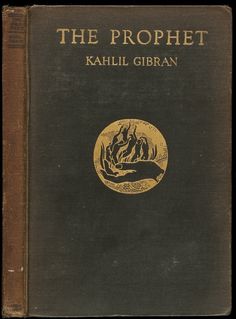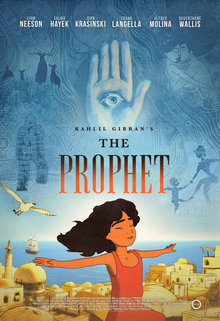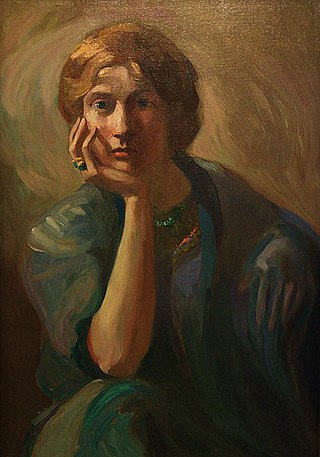Related Research Articles

Gibran Khalil Gibran, usually referred to in English as Kahlil Gibran, was a Lebanese-American writer, poet and visual artist; he was also considered a philosopher, although he himself rejected the title. He is best known as the author of The Prophet, which was first published in the United States in 1923 and has since become one of the best-selling books of all time, having been translated into more than 100 languages.

Gandalf is an Austrian New Age composer. He plays a wide variety of instruments, including guitar, keyboard, synthesizers and sitars. He includes electronic sounds in his music.
A prophet is a person who is believed to speak through divine inspiration.

The Prophet is a book of 26 prose poetry fables written in English by the Lebanese-American poet and writer Kahlil Gibran. It was originally published in 1923 by Alfred A. Knopf. It is Gibran's best known work. The Prophet has been translated into over 100 languages, making it one of the most translated books in history, as well as one of the best selling books of all time. It has never been out of print.

Paul-Gordon Chandler is an author, art curator, interfaith peacemaker, social entrepreneur and former Episcopal clergyperson. He grew up in West Africa (Senegal) and has lived and worked in leadership roles throughout the world, with an emphasis on the Middle East and Africa, with ecumenical publishing, relief and development agencies, the arts and Anglican Communion. His book on Kahlil Gibran, the best-selling Lebanese born poet-artist and author of The Prophet, is In Search of a Prophet: A Spiritual Journey with Kahlil Gibran.

The Gibran Museum, formerly the Monastery of Mar Sarkis, is a biographical museum in Bsharri, Lebanon, 120 kilometres (75 mi) from Beirut. It is dedicated to the Lebanese writer, philosopher, and artist Kahlil Gibran.
Kahlil G. Gibran, sometimes known as "Kahlil George Gibran", was a Lebanese American painter and sculptor from Boston, Massachusetts. A student of the painter Karl Zerbe at the School of the Museum of Fine Arts, Boston, Gibran first received acclaim as a magic realist painter in the late 1940s when he exhibited with other emerging artists later known as the "Boston Expressionists". Called a "master of materials", as both artist and restorer, Gibran turned to sculpture in the mid-fifties. In 1972, in an effort to separate his identity from his famous relative and namesake, the author of The Prophet, Gibran Kahlil Gibran, who was cousin both to his father Nicholas Gibran and his mother Rose Gibran, the sculptor co-authored with his wife Jean a biography of the poet entitled Kahlil Gibran His Life And World. Gibran is known for multiple skills, including painting; wood, wax, and stone carving; welding; and instrument making.

Alexandre Najjar is a Lebanese and French writer, lawyer and literary critic. He was born in Beirut and studied at Panthéon-Assas University and University of Paris 1 Pantheon-Sorbonne. He holds a Doctorate in Business administration and is specialized in banking and finance law. He is the author of more than 30 books translated into more than 12 languages. In addition to poetry and novels, he has written non fiction works like the biography of Khalil Gibran, the author of The Prophet., a book about the 1936 Summer Olympic Games in Nazi Germany and a book about the Arab Spring.
The Baháʼí Faith (بهائی) has a following of at least several hundred people in Lebanon dating back to 1870. The community includes around 400 people, with a centre in Beit Mery, just outside the capital Beirut, and cemeteries in Machgara and Khaldeh. On the other hand, the Association of Religion Data Archives estimated some 3,900 Baháʼís in 2005.

The Kahlil Gibran Memorial Garden is a public garden located at 3100 Massachusetts Avenue, N.W. Washington, D.C., "within a wooded ravine known as Woodland-Normanstone Park". At its center are a bronze sculpture of the Lebanese-American writer, poet and visual artist Kahlil Gibran by Gordon Kray and a star-shaped fountain surrounded by limestone benches engraved with quotes of Gibran.
Gebran is a well-known given name and family name in Arabic. It is also transliterated as Gibran, Jebran, Jibran, Joubran, Jubran, Goubran and Gubran. It might also appear with an additional "e" at the end, like in Gebrane, Gibrane etc.

The Prophet is a 2014 animated drama film adapted from Kahlil Gibran's 1923 book of the same name. Produced by Salma Hayek, whose voice is also present, the production consisted of different directors for each of the film's collective essays, with animation director Roger Allers supervising and credited as screenwriter. Segment directors include Paul and Gaëtan Brizzi, Joan C. Gratz, Mohammed Saeed Harib, Tomm Moore, Nina Paley, Bill Plympton, Joann Sfar and Michal Socha.
Suheil Badi Bushrui was a Palestinian professor, author, poet, critic, translator, and peace maker. He was a prominent scholar in regard to the life and works of the Lebanese-American author and poet Kahlil Gibran.
Henrietta Breckenridge Boughton (1878–1961), better known by her pen name Barbara Young, was an American art and literary critic in the 1920s, as well as a poet. She met Kahlil Gibran at a reading of The Prophet organized by rector William Norman Guthrie in St. Mark's Church in-the-Bowery and served as his secretary from 1925 until his death. She revised and published Gibran's book The Garden of the Prophet, after Mary Haskell made her revisions. Her book This Man from Lebanon: A Study of Kahlil Gibran was published by Alfred A. Knopf on January 15, 1945. Some of her writing was featured in Thomas Moult's anthology The Best Poems of 1931.
The Syrian–Mount Lebanon Relief Committee was an organization "formed in June of 1916 under the chairmanship of Najib Maalouf and the Assistant Chairmanship of Ameen Rihani" in the United States. Kahlil Gibran was its secretary. Its offices were at 55 Broadway, New York. It aimed at working in cooperation with the American Committee for Armenian and Syrian Relief, and raised "some $165,815 in two and a half years from about 15,000 Syrian subscribers in America."

Mary Elizabeth Haskell, later Minis, was an American educator, best known for having been the benefactress of Lebanese-American writer, poet and visual artist Kahlil Gibran.

Charlotte Rose Teller, later Hirsch, also using the pen name John Brangwyn, was an American writer and socialist active in New York City. She graduated in 1899 from the University of Chicago (BA). Her book The Cage was published in 1907. Mark Twain had offered to endorse it "in the form of a letter to the actress Maude Adams". Mary Haskell introduced Teller and Kahlil Gibran to each other in January 1908.
Charlotte Teller came from an eminent Colorado family. Her father, James [Harvey] Teller, later rose to become the Attorney-General of the state, while her uncle, Henry Teller, was a famous and respected Senator.

Pierre Amédée Marcel-Béronneau (1869–1937) was a French Symbolist painter. He first worked at the École des Beaux-Arts de Bordeaux at the same time as Fernand Sabatté then became "one of the most brilliant students" of Gustave Moreau at the École nationale supérieure des Beaux-Arts. He was a member of the Société des Artistes Français.
Madeline Mason-Manheim (1908-1990) was an American poet and translator. Her work was also published under the names Madeline Mason and Tyler Mason. She was married to the outsider artist and novelist Malcolm McKesson.
References
- ↑ "The Prophet, translated. - the Kahlil Gibran Collective Inc".
- ↑ Le Prophète. Les Cahiers nouveaux. Éd. du Sagittaire. 1926.
